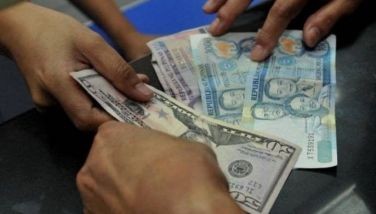PNR: ‘Rolling coffins’ languish in snail-paced modernization

MANILA, Philippines — The man, in his 60s, walks with a swagger and looks dapper in his chambray long-sleeved polo shirt and vintage blue jeans.
He rolls up his denims above the ankle and walks barefoot to the España Station of the Philippine National Railways (PNR), a pair of newly shined brown leather shoes in one hand.
It is raining relentlessly this Saturday afternoon and the whole stretch of España is flooded in knee-high waters filled with floating garbage. Shirtless young boys are playing by the tracks, enjoying the splash and the heavy rains.
The man, Benny Panganiban, calls out to the security guard standing on the other side of the tracks and asks what time the next train will come.
“Will it come at all?,” he asks.
Panganiban is a dance instructor. He is on his way to a client. His shiny shoes can’t be dirty. He has reserved it for the dance floor in a hotel in Parañaque.
He has been taking the train for as long as he can remember because he lives just a few steps from the España Station. It’s not always comfortable, but it takes him to where he needs to be.
Panganiban is just one of the tens of thousands of Filipinos who take the PNR everyday.
It doesn’t always work and today, Panganiban had to wait for more than an hour for the southbound train to arrive. Espana Station was not passable due to the flood.
After a while, the floods finally subside and the train arrives. Panganiban has no choice but to go down the tracks to get to the other side of the station. His feet is wet now, but his shoes are still shiny and dry.
Another regular PNR rider is 27 year old Jenno Leonedo, a construction worker.
Leonedo lives in a community just across a home for the dead in Parañaque. The best way to get to the job site — a laundry shop in progress near España — is to take the train.
“It’s the cheapest for only P20, but today on the way to work, the train bogged down. It happens,” Leonedo said one Monday afternoon last month.
Still, it works for Leonedo and his fellow construction workers. They are after all used to riding the train everyday.
Gauntlet
But whether or not one is a regular train commuter, the experience is more or less the same.
Riding the PNR is like walking the gauntlet. While the coaches are relatively clean and there is an airconditioning system, the whole system itself is problematic and sorely needs modernization.
The trains move very slow and arrivals are unpredictable, depending on whether a coach bogged down or a certain station is flooded — which means the tracks are not passable.
During rush hours, the trains will burst at the seams and almost on cue, the airconditioning system will stop working.
Bad days will see intermittent stops and occasional bog downs. In some stations, the platform is short so commuters have to literally jump out to the ground.
Indeed, the PNR has seen better days, but modernization is ongoing, Transportation Secretary Art Tugade said in an interview with The STAR.
But the fact remains — modernization is as slow as the train’s less than 20 kilometers-per-hour average pace.
Rolling coffins
PNR used to operate over 797 kilometers of route from La Union down to Bicol.
However, neglect by one administration after another reduced PNR’s efficiency and railroad coverage.
It deteriorated so bad that the late senator Ninoy Aquino once called the PNR trains “rolling coffins.”
The state-owned PNR is the sole operator of the most extensive intra-island railway in Luzon.
It operates two commuter rail services in Metro Manila and the Bicol Region, but at present the Bicol service is under rehabilitation.
The mass railway system, which is well patronized by the Filipino working class, traces its history to the Spanish colonial period.
It officially began operations on Nov. 24, 1892 as the Ferrocarril de Manila-Dagupan. It later become the Manila Railroad Com. (MRR) during the American colonial period. It became the Philippine National Railways on June 20, 1964 by virtue of Republic Act 4156, according to data on the PNR website.
Deterioration
However, due to neglect, the PNR deteriorated severely through the decades.
There were also persistent problems with informal settlers in the 1990s which contributed further to PNR’s decline.
In 2006, Typhoons Millennia and Reming caused severe damage to the network, resulting in the suspension of the Manila-Bicol services.
In 2007, the government initiated a rehabilitation project to remove informal settlers from the PNR right-of-way, revitalize commuter services in Metro Manila, and restore the Manila-Bicol route as well as lost services in Northern Luzon, data from the PNR website also showed.
Government actively pursued the rehabilitation and revival of the rail transport through various investments, despite the numerous problems involved.
Stations
The PNR stations are in dire conditions, too. Some, like the main station in Tutuban, are better than others, but most have only basic amenities. Some stations don’t have extended platforms.
It is also rare to see wheelchair ramps.
During rush hours, the snaking lines of commuters can extend all the way to the streets just like in the Buendia Station in Makati.
Ridership
At present, an estimated 75,000 riders take the PNR. But their lives are sometimes at risk by the intermittent problems associated with the PNR system.
Thus, modernization really needs to move faster than its pace now. Union workers also blame mismanagement for PNR’s woes.
Edgar John Bilayon, president of the Bagong Kapisanan ng mga Manggagawa sa PNR (BKMP), alleged that a major disruption of railway services last September happened because officers reportedly sat on a request for the purchase of diesel fuel, the primary source of power of rail engines.
Because of the lack of fuel, 14 rail coaches failed to run, affecting operations and disrupting the lives of commuters.
121 years
The PNR has had a long history. But without the proper attention, the commuter system may deteriorate further.
“From the time the first rail tracks were laid in the Manila-Dagupan Ferrocaril line near the end of the colonial period, until today, without the interventions of two world wars, two revolutions, countless typhoons, volcanic eruptions, bureaucratic neglect and mismanagement, our trains would have been running for 121 years,” the PNR said.
If the system is modernized and given the attention it deserves, it has the potential to significantly ease severe traffic congestion in Metro Manila.
Tugade maintained that the Duterte administration is doing its best to modernize the PNR.
“We will change the system in two and a half years,” Tugade said in an interview in September .
But he conceded that it’s a difficult task.
“The tracks are old or being stolen and there are informal settlers who do not want to leave. But it’s not safe for them. You cannot change the coaches without repairing the tracks. There is a process in doing these things. You need to bid. We are doing something about it, but it will take time,” he said.
There will be new trains to accommodate more passengers, he said.
The government plans to buy nine new trains next year to double the capacity of the system to 120,000 passengers from around 50,000 to 70,000 at present.
The PNR already bought seven train coaches in May and two in January from Indonesian state-owned company PT Industri Kereta Api (PT INKA). This is the first time in 40 years that the PNR has purchased new trains.
The train coaches are expected to be delivered in 2019 amid ongoing rehabilitation of five trains.
These measures are being implemented amid the ongoing construction of the PNR North and South railway projects under the Build Build Build program of the Duterte administration.
However, for now, the PNR trains are still comparable to other modes of public transportation in the country, if not worse. Like the MRT, for instance, trains bog down and the waiting time is long.
In the end, you have to brace yourself for a slow ride in coaches that make you feel you’re in a can of sardines.
For most Filipinos, however, it’s the only choice they have given the cheap fare of a minimum P15.
“There really isn’t much choice. Other forms of transportation are expensive. Besides, it doesn’t bog down everyday,” said Leonedo, the construction worker.
- Latest
- Trending






























